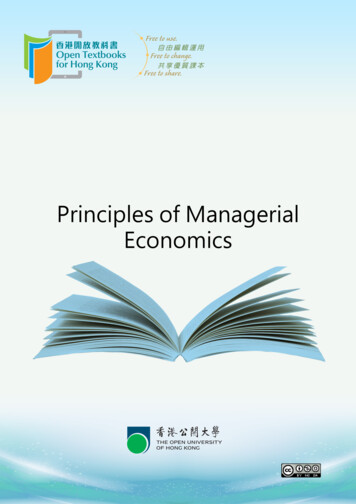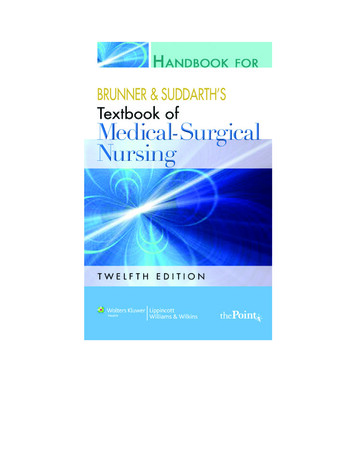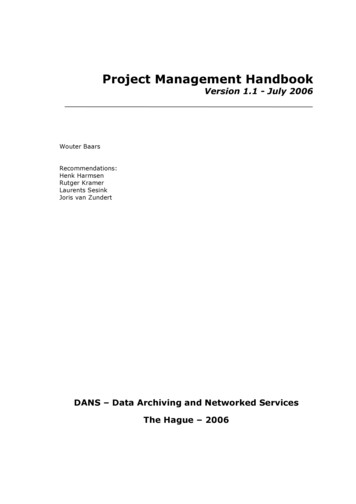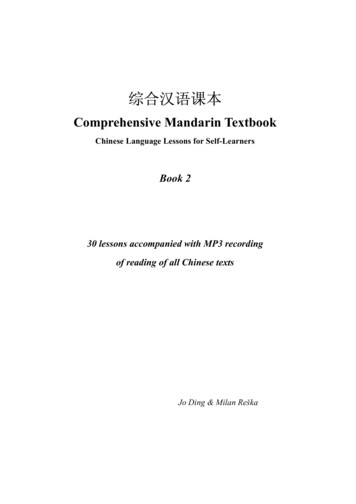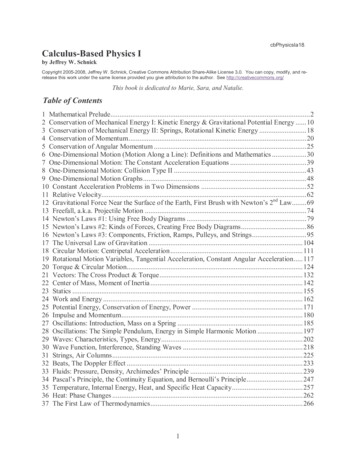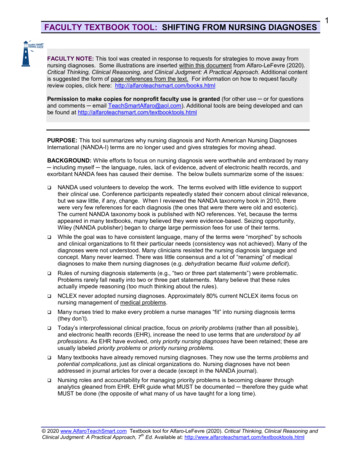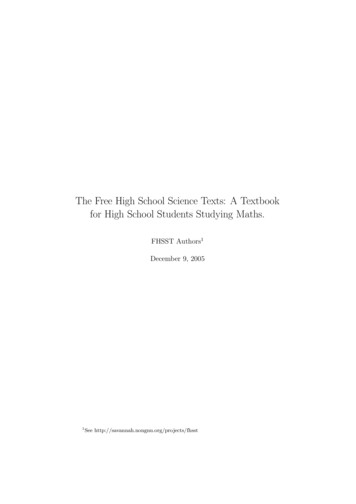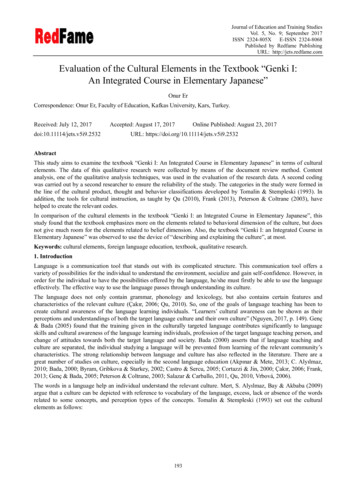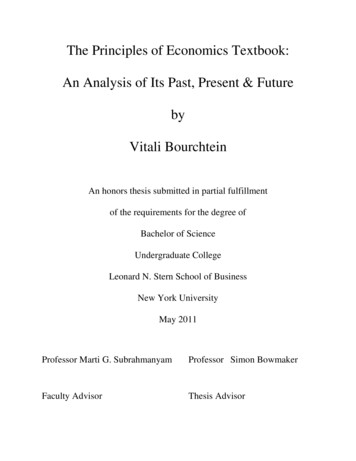
Transcription
The Principles of Economics Textbook:An Analysis of Its Past, Present & FuturebyVitali BourchteinAn honors thesis submitted in partial fulfillmentof the requirements for the degree ofBachelor of ScienceUndergraduate CollegeLeonard N. Stern School of BusinessNew York UniversityMay 2011Professor Marti G. SubrahmanyamProfessor Simon BowmakerFaculty AdvisorThesis Advisor
Bourchtein 1Table of ContentsAbstract .4Thank You .4Introduction .5Summary .5Part I: Literature Review .6David Colander – What Economists Do and What Economists Teach .6David Colander – The Art of Teaching Economics .8David Colander – What We Taught and What We Did: The Evolution of US EconomicTextbooks (1830-1930) .10Mark Skousen – The Perseverance of Paul Samuelson’s Economics .12Part II: Methodology – Approach Taken and Books Used .15Approach Taken .15Books Used .16Part III: Analysis .17Textbook Size .17Consensus Text .18Microeconomics .19Supply and Demand .20Macroeconomics .21Aggregate Supply and Aggregate Demand .22Game Theory .23Behavioral Economics .24Labor Economics .26Economics of the Family.27Law and Economics .28Public Economics .29Health Economics .30Industrial Organization .31Environmental Economics .32
Bourchtein 2Urban Economics .33Race and Gender .34History of Economic Thought .35Money and Banking .36Fiscal Policy .37Economic Growth .38Development Economics .39International Trade .40Part IV: Concluding Thoughts and Future Outlook .41Summary of Findings .41The Future of Principles of Economics .43Exhibit A .45Exhibit B .46Exhibit C .47Exhibit D .48Exhibit E .49Exhibit F.50Exhibit G .51Exhibit H .52Exhibit I .53Exhibit J .54Exhibit K .55Exhibit L .56Exhibit M .57Exhibit N .58Exhibit O .59Exhibit P.60Exhibit Q .61Exhibit R .62Exhibit S.63
Bourchtein 3Exhibit T .64Exhibit U .65Exhibit V .66Exhibit W .67Exhibit X .68Works Cited .71
Bourchtein 4AbstractEconomics plays a large role in today’s society, as it affects the majority of our decisions,as well as the decisions made by other individuals, corporations and governments. As a result,economics is one of the most popular college majors. The study of economics usually beginswith a student taking a principles of economics course. The majority of the principles classes usetextbooks, which is why these books play a large role in economics education. This paperexamines the past, present and future of the principles of economics textbooks. 12 differenttextbooks were analyzed and a “consensus” textbook based on the amount of pages dedicated to21 different topics was created. Following that, each of the 21 topics was further analyzed. Theanalysis included the maximum, minimum and average percentage of the textbook allocated toeach topic, as well as the description of subtopics that were covered or not covered under each ofthe chosen 21 topics. This thesis arrived at four main conclusions. First, over the past 20 years,the average size of the principles of economics textbook decreased from 900 to 757 pages.Second, the world is more global now than it was 20 years ago, yet there is actually less attentiongiven to international trade in the textbooks. Third, there is very little attention given to veryimportant topics, such as behavioral economics, development economics, game theory,economics of the family, and law and economics. Fourth, the change in principles of economicstextbooks has been very slow.Thank YouI would like to thank Professor Simon Bowmaker for his continuous support and guidancethroughout the entire process of writing my thesis. I would also like to thank Professor MartiSubrahmanyam and Advisor Jessie Rosenzweig for organizing and facilitating such a wonderfulprogram. Lastly, I would like to thank everyone in the 3rd floor leadership lounge for providingan amazing environment for working on this thesis.
Bourchtein 5IntroductionEconomics is a science that examines the production, distribution, and consumption ofgoods and services, as well as the creation of wealth. The current studies of the economics fieldcan be traced back to the study of the political economy in the 19th century. As the study ofmathematics developed, the study of economics followed. The empirical approach has shapedtoday’s economics and has helped to develop current economic models. Studying economicsprovides many valuable benefits, such as the knowledge that is needed to understand the impactof developments in business, society and the world economy. The study of economics aidsindividuals in understanding the decisions of households, businesses and governments based onbeliefs, human behavior, structure, needs and constraints. It also provides one with manyopportunities and benefits besides simply understanding the finance industry; it teaches us aboutchoice, opportunity, scarcity and the impact of decision making on society. Principles ofmicroeconomics and macroeconomics classes are taken by many students in thousands ofdifferent universities and colleges around the United States and the world. Students learn manypractical theories in these classes, like how to use their money when buying new things byunderstanding the concepts of supply and demand. Since economics plays such a large role in thedaily life of Americans, it is important to understand how it is taught to the younger generations.SummaryThis thesis is going to analyze the content of principles of economics classes with a focuson textbooks by performing a content examination of 12 principles of economics textbooks andevaluating the page allocation given to different topics. From this point, the thesis will bestructured as follows:
Bourchtein 6a) Part I: literature review of principles of economics textbooks, which will include writingson the way economics is currently taught, as well as an analysis of the history ofprinciples of economics textbooksb) Part II: a description of the methodology used and the approach taken in writing thisthesis, as well as an introduction of the twelve textbooks that were usedc) Part III: an analysis of the researchd) Part IV: concluding thoughts and analysis of the future of principles of economicstextbooksPart I – Literature ReviewDavid Colander – What Economists Do and What Economists TeachIn this article, David Colander discusses the differences that exist today between whateconomists do in their day-to-day work and what they teach to their students. At one point intime, what economists did and taught were the same. However, the profession and the textbookshave evolved very differently. The changes in the work that economists do can be attributed totechnological advances. These technological advances have made computers a crucial part ofresearch and have made the research itself a lot more technical. These changes came with theunderstanding that the economy is a very complex system, and that a lot of the research is nolonger possible without technology. However, what economists teach has not evolved the sameway. Most economics lectures are a lot closer to story-telling than to mathematics. The teachingof economics has been very slow in adopting the technological advances in research into thecurriculum. The current structure of principles of economics textbooks reflects Samuelson’s
Bourchtein 7textbook from 1948, which was written before mathematics began to play as big of a role inresearch as it does today. However, Colander writes that increasing mathematics in principles ofeconomics textbooks is not the solution to the problem, as only 1% of principles students go onto economic research. Microeconomics today focuses on what Colander calls the “efficiencytheory” – the books discuss in detail how rational individuals make decisions and how resultsthat are beneficial for the common good arise from rational individuals’ actions channeled by themarkets. Principles classes and textbooks tend to focus on scarcity and constrained optimization.On the macroeconomics side, the focus is also on efficiency and on the idea that restrictions limitefficiency. Colander says that such an approach is good for entry level classes but that it haslimitations, and these theories are expanded upon in higher level economics courses.Samuelson wrote his first textbook more than 60 years ago. At the time that it waswritten, his microeconomic explanations were along the lines of what all cutting-edgeeconomists thought. Today, what economists think has changed drastically, but the textbookshave not followed. Colander believes that eventually textbooks will reflect the changes ineconomists’ thinking, but at this point there is too much capital tied up for these changes to occurrapidly. Colander expects two main changes in the principles of economics textbook. The firstone will be that the story currently told in principles of economics will evolve. Then, long in thefuture, there will be an entirely new type of textbook built on induction.Colander sees five main ways that the current textbook can evolve to better reflect thework that economists around the world do. The first such change would be for the currentmodels not to be depicted as the truth but rather as a logical exercise. Such models are veryhelpful for students to better understand the reality, but they should not be assumed to be the
Bourchtein 8actual reality. The second change Colander suggests is to deemphasize efficiency. Many currenttextbooks label efficiency as the goal of society, which is not necessarily the case. As a result,more attention should be dedicated to behavioral economics and failures of market outcomes.The third change should be in the way equilibrium is currently presented. Many books refer tothe equilibrium as the state of the economy, while in reality it is just a state of the model.Another solution to this issue would be to present models with multiple equilibria. The fourthsuggestion that Colander makes is to present rationality as reasonableness rather than rationality,and to integrate behavioral considerations into discussions. The fifth change mentioned would beto introduce to students non-linear dynamic models to allow them to understand issues that theefficiency theory often ignores.Colander concludes this article by saying that overall, students learn a great deal inprinciples of economics classes and aligning the curriculum with what economists actually do isnot a requirement for good teaching of economics.David Colander – The Art of Teaching EconomicsThe main message that this article sends to its readers is that content and not form iscentral to teaching economics. There are two main responsibilities that a professor has – teachingand research. Many of the best researchers find teaching an annoying task that comes with theirjobs as researchers at universities. Colander’s paper wasn’t directed at those faculty members butrather at the ones who like to teach and who like to research different teaching methods andtechniques. According to Colander, there are many people today that wrongly believe that gooddelivery skills are the most important ability for a professor. However, it is content that
Bourchtein 9determines whether one is a good teacher or not. Even though this is a bigger problem in highschools than universities, it is still a problem in higher level education as well.The new paradigm in teaching is that there isn’t enough focus on content. Professorsworry a lot about how they deliver their content. They want to be funny and liked, which are allimportant things, as long as content doesn’t suffer as a result. However, it often does. Colanderdoes not think that a teacher should be on a voyage of discovery. The teachers shouldn’t try tolearn from the students nor have the students learn from each other. Professors are there to sharetheir knowledge to the class, and that’s what they should be doing.Colander writes that good teachers get their students to learn through motivating and notthrough trying to relate to them. This does not mean that the tone of the lecture shouldn’t beconversational. As a matter of fact, that’s definitely recommended, because it’s more likely tokeep students engaged in the issues that are being discussed. Faculty members often make themistake of falsely assuming that all the students in their classes are motivated to learn. Colanderrealizes that such is not true, and he thus gives students five minute quizzes at the beginning ofevery lecture to make sure they’re staying on top of the lectures and the homework readings. Hedoesn’t even let his students take notes in his class because he feels that listening carefully towhat he is saying is too important. Colander highly values student-faculty interaction and notesthat availability of faculty for such interactions is crucial to successful learning. He does notethat professors do not need to empower their students, they just need to make sure that they aretaught well and that they learn.Colander then gives his recommendations for assessment in principles of economicsclasses. Firstly, he notes that the best method of assessment varies with the size of the class.
Bourchtein 10Colander does believe in grading on a curve – he does not believe that students should need toknow 95% of the material to get an A. Lastly, Colander shares his opinion on the use oftechnology in classrooms. He believes that some technology should have a place in theclassroom, such as e-mail, and that others are not as important, such as multimedia.David Colander – What We Taught and What We Did: The Evolution of US EconomicTextbooks (1830-1930)This article begins with a claim that today there is a much larger gap between whateconomists do and what economics professors teach than ever before, specifically between 1830and 1930. There is one main reason that explains this – there has been a drastic shift fromqualitative research to mathematical economic research.Historically, economics has been taught as a single class to seniors. Today, for manystudents, the principles of economics classes are a beginning of the journey of studyingeconomics. In the 1800s, the principles class was the entire study. Over time, economics becamea more established field. A look at the textbooks of that time period shows that economicsresembled moral philosophy much more than it resembled a science.The largest selling textbook during this time period was Political Economy by FrancisWayland. The first edition was published in 1837. The book had very little technical economicanalysis. Instead, as Colander writes, it “philosophized.” The book had a large emphasis on theidea of good versus bad and the morality of actions. The largest emphasis in the book was placedon “exchange” – a theological harmony of the way the economy works. Labor was divided intoproductive and unproductive labor. The connection between the Church and the financiers was
Bourchtein 11described, which established the connection between the financial sector and the real economy atthe time. This book labeled economics as a branch of social science.Another important textbook of this time period was Francis Walker’s Political Economy,first published in 1883. This book symbolizes the development of Marxian economics and thebeginning of graduate study in economics. This book also showed that mathematics was slowlybeginning to be included in principles of economics textbooks. This book had no graphs, charts,tables or entries for Marx, Edgeworth or Walras. The book was divided into five sections:method, production, exchange, distribution and consumption, and a final part on applications.The next important book of the time period was Maffeo Pantaloni’s Pure Economics,which has been labeled by many the beginning of modern economics, since the book includedtheorems and theories. First edition was published in 1905, and the book’s focus was oneconomics itself and not on political economy, unlike the majority of its predecessors. Thistextbook had graphs, as well as chapters on supply and demand, the theory of utility and thetheory of value.There was also the text Economics written by Edwin Seligman in 1907. Pantaloni’stextbook did not catch on in the United States, and the books remained focused on politicaleconomy rather than on economics. Seligman was a generalist and not a pure economist, but wascloser to being one than most previous authors. Although there aren’t any graphs in the book,there are charts and tables. This book provided more historical discussion than the previoustextbooks, and it also provided different views on free trade than ever before.
Bourchtein 12The tradition formed by these books ended in 1960 with the publishing of Samuelson’sEconomics. The book was structured around more theoretical and mathematical approaches.Mark Skousen – The Perseverance of Paul Samuelson’s EconomicsThis book is the foundation of today’s economics pedagogy. Samuelson’s textbook wentthrough 15 editions and sold over one million copies. Samuelson introduced Keynes to students.He is also credited with introducing many terms to the economics language that are widely usedtoday: the multiplier, propensity to consume, the paradox of thrift, and countercyclical fiscalpolicy just to name a few. By the 4th edition, Samuelson declared that 90% of the economistshave stopped being Keynesian or anti-Keynesian. In the 12th edition, Samuelson introduced theconcepts of aggregate demand and aggregate supply. Samuelson’s earlier editions made it seemlike Keynesian was the only school of thought, while in reality it was heavily debated in the1940s and 1950s.Samuelson had very strong anti-saving views. This bias was found in most of his versionsuntil the recent editions. His view was that greater consumption, not greater saving, was the keyto prosperity. However, his views on saving changed in the later versions of the textbook. Hisviews on government budget deficits changed as well. Originally, he believed that such deficitswere a good thing. As you can imagine, few economists today think that way about the currentbudget deficit of the United States. Samuelson caught on as well, stating in his last book thatlarge public debt can clearly be detrimental to long-term economic growth.Samuelson’s views on monetary policy have evolved as well. In the earlier versions,fiscal policy was emphasized more than monetary policy. In the later versions, the opposite was
Bourchtein 13true. Milton Friedman and Irving Fisher both were not mentioned in some of the editions of thebook, although the later editions did mention both of their names.Samuelson was an avid defender of an activist government. Through 15 editions of thetextbook, he clearly favored a significant role of the state. He argued that increasing taxes werejust a by-product of economic and social development. He was against supply-side tax cuts, butsupported the Keynesian-oriented ones. He was in favor of welfare and anti-poverty programs.After the 5th edition, the chapter on personal finance was removed. There are several reasonswhy social security deserved more attention. Today, more than 50% of Americans pay more inpayroll taxes than income taxes, social security is in the middle of a conflict aboutintergenerational equity, and there exist several possibilities of revamping the system, such asprivatization. Samuelson’s texts did not give enough attention to the significance of governmentfailures in making decisions. Since the 12th edition, there are numerous listings under marketfailures but none under government failures. Samuelson even said that harmful governmentpolicies are probably rare.Samuelson wanted to homogenize mainstream economics. To do that, he created agenealogical diagram of economic thought from the Greeks to the present day. According to thischart, in the 20th century only two schools of economic thought remained: Marxist-Leninistsocialism and Marshall-Keynes neoclassical synthesis. More space was dedicated to nonKeynesian economic thought in the later editions. Beginning in the 9th edition, the references ofMarx and Engels increased. However, with the fall of the Soviet Union, the discussion of Marxdecreased significantly.
Bourchtein 14At first, Samuelson was very skeptical about socialism. By the middle editions,Samuelson included statistics showing that the Soviet Union was narrowing, or even closing, itsgap with the United States. In the 13th edition, Samuelson wrote that, contrary to what manypeople believe, the Soviet economy is proof that a command economy can function and eventhrive. The word “thrive” was deleted in the next version, which was published during the fall ofthe Soviet Union. Question marks were placed next to the statistics regarding the USSR.Samuelson did admit that his textbooks failed to anticipate the collapse of the Soviet Union.Samuelson overplayed the economic success of the Soviet Union, but he underplayed thesuccess of the economies of Germany and Japan. The one paragraph he dedicated to the recoveryof West Germany’s economy did not do it justice. Japan, which went from a starving nation to asuperpower in 25 years, was also barely mentioned. Even when other economics textbooksbegan giving more emphasis to global issues, Samuelson did not. Only in the 13th edition, thehigh performing economies of East Asia were mentioned. In that edition, a total of twoparagraphs were given to all of East Asia’s economic miracles. The economic successes ofcountries in Latin America did not even get mentioned.On the positive side, Samuelson was very optimistic about the US economy, he waswilling to update the textbooks with new theories and events, and he gave more emphasis tomonetary policy, saving and markets in the latest editions of his textbooks. Samuelson had alaissez-faire approach to microeconomic issues, but favored heavy involvement in stabilizing theeconomy as a whole. Samuelson was very critical of Marx; he weighed in on the burdens ofnational debt, denied that war and price controls were good for the economy, and questionedwhether labor unions can raise wages. Even though some of his advice and opinions are
Bourchtein 15questionable in light of today’s knowledge, his influence on modern principles of economicscourses, and economics education in general, is unquestionable.Part II – Methodology: Approach Taken and Books UsedApproach TakenThis thesis analyzed twelve current principles of ec
textbooks, which is why these books play a large role in economics education. This paper examines the past, present and future of the principles of economics textbooks. 12 different textbooks were analyzed and a “consensus” textbook based on the amou

